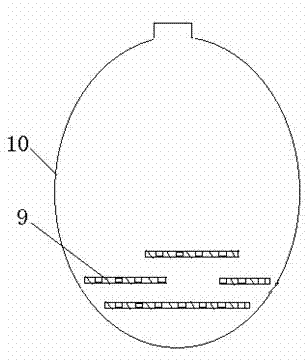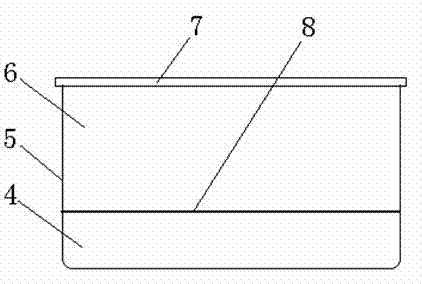Method for trapping and breeding giant silkworms
A technique of trapping and trapping silkworms, which is applied in the field of trapping and cultivating silkworms, can solve the problems of larvae and cocoons susceptible to disease, and the inability to realize large-scale breeding, and achieve high survival rate, promote the industrialization of silkworms, and achieve high efficiency effects
- Summary
- Abstract
- Description
- Claims
- Application Information
AI Technical Summary
Problems solved by technology
Method used
Image
Examples
Embodiment 1
[0037] A. During the moth catching period, that is, at the beginning of April (Yunnan) every year, a support 1 with a height of 2 meters is erected, and a high-pressure mercury lamp 2 is set on the top of the support 1. A reflector 3 with a height of 4 meters is set on one side of the high-pressure mercury lamp 2, and the control light intensity is 100000 lux. At the high-pressure mercury lamp, use the sex pheromone secreted by the female ceper moth to attract the male ceper moth, and trap the male ceper moth with a net bag;
[0038] B. The male and female cerci moths captured in step A are paired and fertilized in the dark with a temperature of 24°C and a humidity of 60% at a ratio of male cerci moths: female ceper moths=3:1;
[0039] C. Spray the hormone mixed solution to the female celecia moth fertilized in step B, and lay eggs on the ovipositor at a temperature of 28°C and a humidity of 75%, wherein: the hormone mixed solution is in the amount of 10mg / 10000 heads, Th...
Embodiment 2
[0046] A. During the moth catching period, that is, at the beginning of September (Yunnan) every year, a support 1 with a height of 2 meters is erected, and a high-pressure mercury lamp 2 is set on the top of the support 1. A reflector 3 with a height of 4 meters is set on one side of the high-pressure mercury lamp 2, and the control light intensity is 150000 lux. At the high-pressure mercury lamp, use the sex pheromone secreted by the female ceper moth to attract the male ceper moth, and trap the male ceper moth with a net bag;
[0047] B. The male and female cerci moths captured in step A are paired and fertilized in the dark with a temperature of 27°C and a humidity of 80% at a ratio of male cercis moths: female cercis moths=5:3;
[0048] C. Spray the hormone mixed solution to the female celecia moth fertilized in step B, and lay eggs on the ovipositor at a temperature of 30°C and a humidity of 75%, wherein: the hormone mixed solution is in the amount of 30mg / 10000 head...
PUM
 Login to View More
Login to View More Abstract
Description
Claims
Application Information
 Login to View More
Login to View More - R&D
- Intellectual Property
- Life Sciences
- Materials
- Tech Scout
- Unparalleled Data Quality
- Higher Quality Content
- 60% Fewer Hallucinations
Browse by: Latest US Patents, China's latest patents, Technical Efficacy Thesaurus, Application Domain, Technology Topic, Popular Technical Reports.
© 2025 PatSnap. All rights reserved.Legal|Privacy policy|Modern Slavery Act Transparency Statement|Sitemap|About US| Contact US: help@patsnap.com



